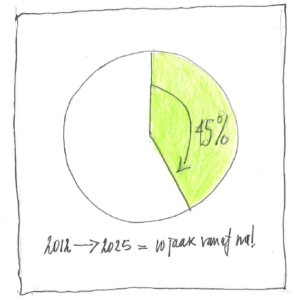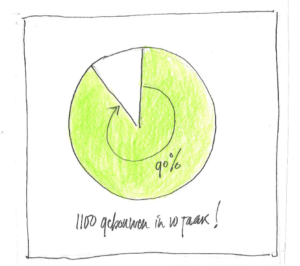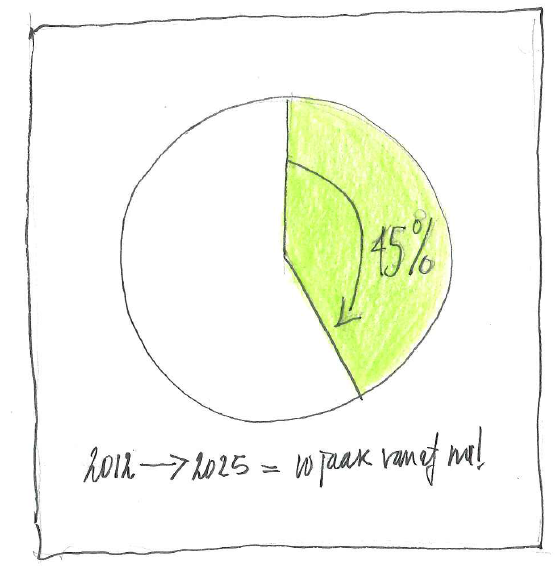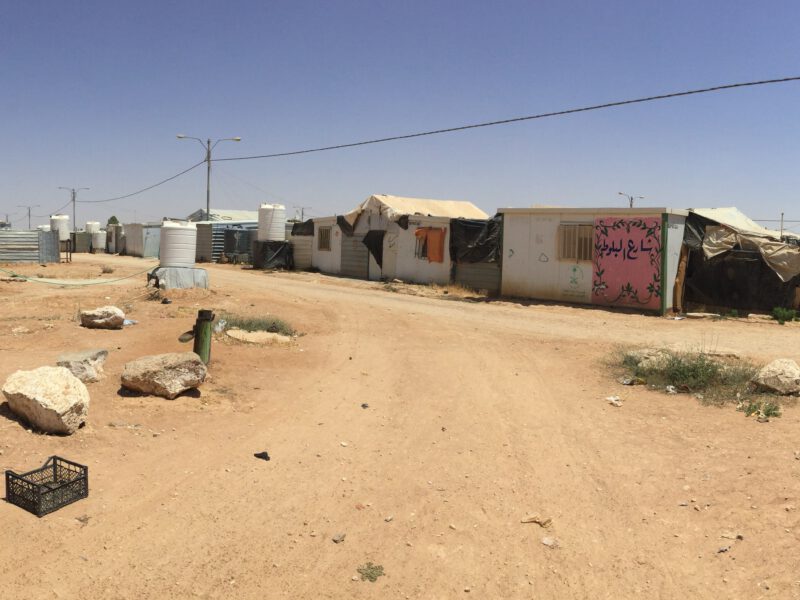 The more I read about and work on energy transition in the urban context the less I seem to understand. Is it because of its complexity? To understand a little better I will analyse one of the goals of the city of Amsterdam I found in the Sustainable agenda: the energy consumption of municipal buildings.
The more I read about and work on energy transition in the urban context the less I seem to understand. Is it because of its complexity? To understand a little better I will analyse one of the goals of the city of Amsterdam I found in the Sustainable agenda: the energy consumption of municipal buildings.
According to the agenda the municipality wants to diminish CO2 emissions of the municipal organization by 45 percent in 2025, compared to 2012. I assume it is also about its buildings. I made a simple drawing and we have 10 years to go.
I know the municipality already has a contract for green electricity. investing in for instance solar panels could be smart but will not contribute to the goal. So I have to focus on gas consumption for heating and cooling. There are buildings connected to district heating but most are connected to the gas infrastructure.
If you want to diminish the gas (heat) consumption of a building by 45% you have a serious challenge. You can only reach this goal after a big refit and a big investment.
On the internet I found that the city uses and owns about 2.200 buildings of different size, year of construction and quality.
Investments in buildings are normally done at a certain moment in time. Let?s say ? for this exercise – once in twenty years. Then the refit is serious enough to add the investment to meet the mentioned energy challenge.
 The city needs to refit approximately 1.100 buildings in the next 10 year; about 110 buildings a year.
The city needs to refit approximately 1.100 buildings in the next 10 year; about 110 buildings a year.
But after adapting 1.100 buildings in 2025, the city is only half way. To meet its goals the gas consumption of all refitted buildings need to shrink by 90%.
WOW, I am getting a clue of the challenge that is energy transformation!
Let?s reason on. Pareto was an Italian economist and he discovered the 80?20 rule; also known as the Pareto principle. It is the law of the vital few. It states that roughly 80% of the effects come from 20% of the causes. Then maybe we do not have to refit all buildings.
Following the Pareto principle we can assume that 80% of the gas is consumed by only 20% of the buildings. But the principle also states that the floor area of these buildings is 80% of the total area of all buildings.
In conclusion I want to state that we have to refit, in the next ten years, about 22 of the biggest municipal buildings. So the number of projects is less than I expected. If we compensate for the 20%, let?s assume we need to refit four to six buildings more. Feels like a relief?
If it comes to investments the rule is not useful. The floor space stays the same. Who has a clue about the floor space of the mentioned buildings and who has an idea of the needed investments per square meter? If you have them please let me know. I am really curious and I will discuss it in a next post.



